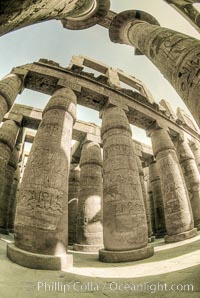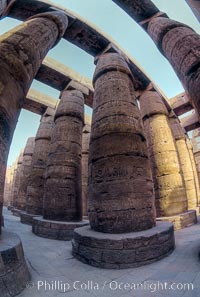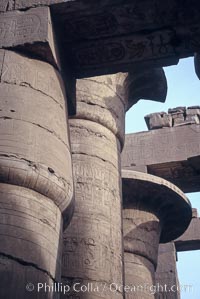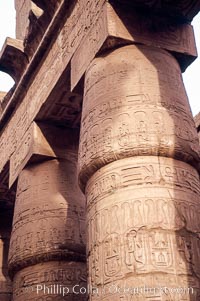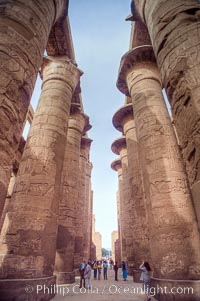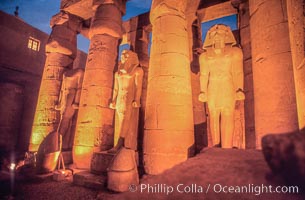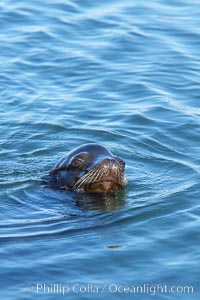
California sea lion swimming.
Species: California sea lion, Zalophus californianus
Location: Columbia River, Astoria, Oregon
Image ID: 19436
Species: California sea lion, Zalophus californianus
Location: Columbia River, Astoria, Oregon
Image ID: 19436
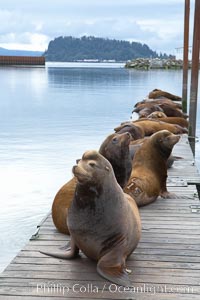
Sea lions hauled out on public docks in Astoria's East Mooring Basin. This bachelor colony of adult males takes up residence for several weeks in late summer on public docks in Astoria after having fed upon migrating salmon in the Columbia River. The sea lions can damage or even sink docks and some critics feel that they cost the city money in the form of lost dock fees.
Species: California sea lion, Zalophus californianus
Location: Columbia River, Astoria, Oregon
Image ID: 19437
Species: California sea lion, Zalophus californianus
Location: Columbia River, Astoria, Oregon
Image ID: 19437
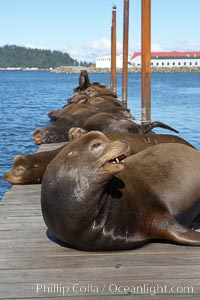
Sea lions hauled out on public docks in Astoria's East Mooring Basin. This bachelor colony of adult males takes up residence for several weeks in late summer on public docks in Astoria after having fed upon migrating salmon in the Columbia River. The sea lions can damage or even sink docks and some critics feel that they cost the city money in the form of lost dock fees.
Species: California sea lion, Zalophus californianus
Location: Columbia River, Astoria, Oregon
Image ID: 19438
Species: California sea lion, Zalophus californianus
Location: Columbia River, Astoria, Oregon
Image ID: 19438
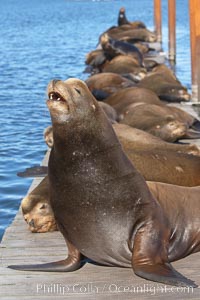
Sea lions hauled out on public docks in Astoria's East Mooring Basin. This bachelor colony of adult males takes up residence for several weeks in late summer on public docks in Astoria after having fed upon migrating salmon in the Columbia River. The sea lions can damage or even sink docks and some critics feel that they cost the city money in the form of lost dock fees.
Species: California sea lion, Zalophus californianus
Location: Columbia River, Astoria, Oregon
Image ID: 19439
Species: California sea lion, Zalophus californianus
Location: Columbia River, Astoria, Oregon
Image ID: 19439
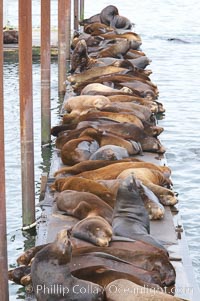
Sea lions hauled out on public docks in Astoria's East Mooring Basin. This bachelor colony of adult males takes up residence for several weeks in late summer on public docks in Astoria after having fed upon migrating salmon in the Columbia River. The sea lions can damage or even sink docks and some critics feel that they cost the city money in the form of lost dock fees.
Species: California sea lion, Zalophus californianus
Location: Columbia River, Astoria, Oregon
Image ID: 19440
Species: California sea lion, Zalophus californianus
Location: Columbia River, Astoria, Oregon
Image ID: 19440
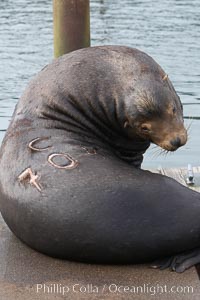
A bull sea lion shows a brand burned into its hide by the Oregon Department of Fish and Wildlife, to monitor it from season to season as it travels between California, Oregon and Washington. Some California sea lions, such as this one C-704, prey upon migrating salmon that gather in the downstream waters and fish ladders of Bonneville Dam on the Columbia River. The "C" in its brand denotes Columbia River. These sea lions also form bachelor colonies that haul out on public docks in Astoria's East Mooring Basin and elsewhere, where they can damage or even sink docks.
Species: California sea lion, Zalophus californianus
Location: Columbia River, Astoria, Oregon
Image ID: 19441
Species: California sea lion, Zalophus californianus
Location: Columbia River, Astoria, Oregon
Image ID: 19441
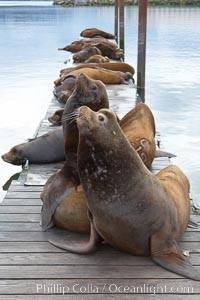
Sea lions hauled out on public docks in Astoria's East Mooring Basin. This bachelor colony of adult males takes up residence for several weeks in late summer on public docks in Astoria after having fed upon migrating salmon in the Columbia River. The sea lions can damage or even sink docks and some critics feel that they cost the city money in the form of lost dock fees.
Species: California sea lion, Zalophus californianus
Location: Columbia River, Astoria, Oregon
Image ID: 19442
Species: California sea lion, Zalophus californianus
Location: Columbia River, Astoria, Oregon
Image ID: 19442
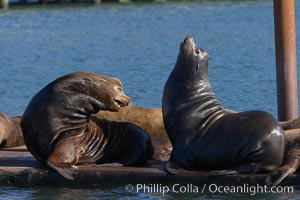
Sea lions hauled out on public docks in Astoria's East Mooring Basin. This bachelor colony of adult males takes up residence for several weeks in late summer on public docks in Astoria after having fed upon migrating salmon in the Columbia River. The sea lions can damage or even sink docks and some critics feel that they cost the city money in the form of lost dock fees.
Species: California sea lion, Zalophus californianus
Location: Columbia River, Astoria, Oregon
Image ID: 19443
Species: California sea lion, Zalophus californianus
Location: Columbia River, Astoria, Oregon
Image ID: 19443
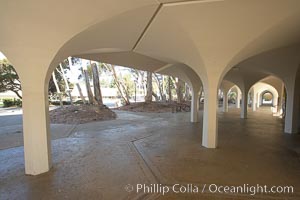
Columns, York Hall, Revelle College, University of California San Diego, UCSD.
Image ID: 21221
Image ID: 21221
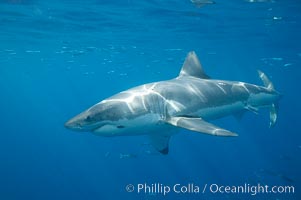
A great white shark is countershaded, with a dark gray dorsal color and light gray to white underside, making it more difficult for the shark's prey to see it as approaches from above or below in the water column. The particular undulations of the countershading line along its side, where gray meets white, is unique to each shark and helps researchers to identify individual sharks in capture-recapture studies. Guadalupe Island is host to a relatively large population of great white sharks who, through a history of video and photographs showing their countershading lines, are the subject of an ongoing study of shark behaviour, migration and population size.
Species: Great white shark, Carcharodon carcharias
Location: Guadalupe Island (Isla Guadalupe), Baja California, Mexico
Image ID: 19484
Species: Great white shark, Carcharodon carcharias
Location: Guadalupe Island (Isla Guadalupe), Baja California, Mexico
Image ID: 19484
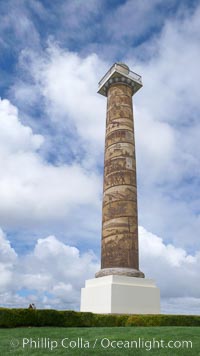
The Astoria Column rises 125 feet above Coxcomb Hill, site of the first permanent American Settlement west of the Rockies, itself 600 feet above Astoria. It was erected in 1926 and has been listed in the National Register of Historic Places since 1974. The column displays 14 scenes commemorating important events in the history of Astoria in cronological order. An interior 164-step spiral staircase leads to the top of a viewing platform with spectacular views.
Location: Astoria, Oregon
Image ID: 19444
Location: Astoria, Oregon
Image ID: 19444
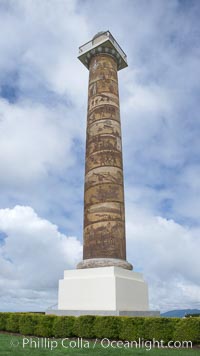
The Astoria Column rises 125 feet above Coxcomb Hill, site of the first permanent American Settlement west of the Rockies, itself 600 feet above Astoria. It was erected in 1926 and has been listed in the National Register of Historic Places since 1974. The column displays 14 scenes commemorating important events in the history of Astoria in cronological order. An interior 164-step spiral staircase leads to the top of a viewing platform with spectacular views.
Location: Astoria, Oregon
Image ID: 19445
Location: Astoria, Oregon
Image ID: 19445
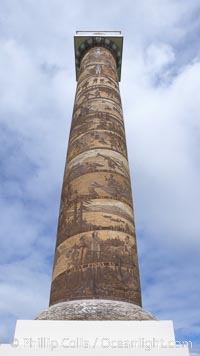
The Astoria Column rises 125 feet above Coxcomb Hill, site of the first permanent American Settlement west of the Rockies, itself 600 feet above Astoria. It was erected in 1926 and has been listed in the National Register of Historic Places since 1974. The column displays 14 scenes commemorating important events in the history of Astoria in cronological order. An interior 164-step spiral staircase leads to the top of a viewing platform with spectacular views.
Location: Astoria, Oregon
Image ID: 19446
Location: Astoria, Oregon
Image ID: 19446
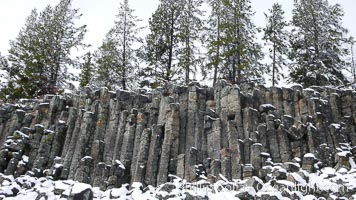
Sheepeater Cliffs, an example of columnar jointing in basalt due to shrinkage during cooling.
Location: Yellowstone National Park, Wyoming
Image ID: 19794
Location: Yellowstone National Park, Wyoming
Image ID: 19794
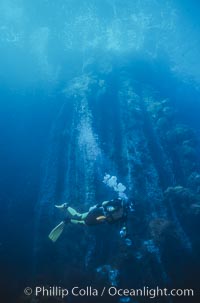
Basaltic columns, Los Arcos del Diablo.
Location: Guadalupe Island (Isla Guadalupe), Baja California, Mexico
Image ID: 06188
Location: Guadalupe Island (Isla Guadalupe), Baja California, Mexico
Image ID: 06188
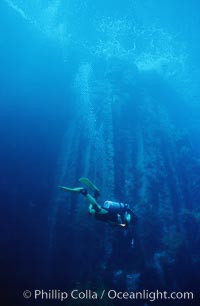
Basaltic columns, Los Arcos del Diablo.
Location: Guadalupe Island (Isla Guadalupe), Baja California, Mexico
Image ID: 06187
Location: Guadalupe Island (Isla Guadalupe), Baja California, Mexico
Image ID: 06187
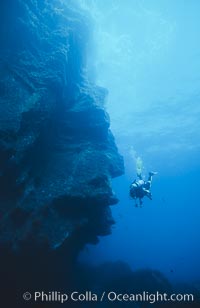
Basaltic columns, Los Arcos del Diablo.
Location: Guadalupe Island (Isla Guadalupe), Baja California, Mexico
Image ID: 06192
Location: Guadalupe Island (Isla Guadalupe), Baja California, Mexico
Image ID: 06192
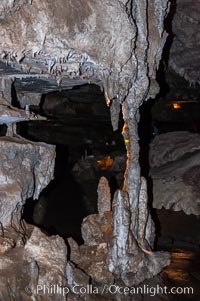
Calcite stalactites hanging from above have joined with stalagmites growing on the cave floor to form a solid column.
Location: Crystal Cave, Sequoia Kings Canyon National Park, California
Image ID: 09922
Location: Crystal Cave, Sequoia Kings Canyon National Park, California
Image ID: 09922
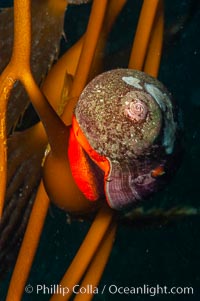
Norris topsnail (aka, kelp snail), clings to a kelp pneumatocyst (bubble) at the base of a stipe/blade, midway in the water column.
Species: Norris' top snail, Macrocystis pyrifera, Norrisia norrisi
Location: San Nicholas Island, California
Image ID: 10212
Species: Norris' top snail, Macrocystis pyrifera, Norrisia norrisi
Location: San Nicholas Island, California
Image ID: 10212
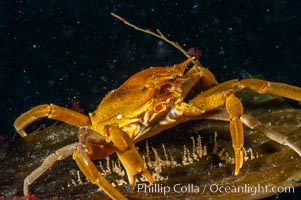
Northern kelp crab crawls amidst kelp blades and stipes, midway in the water column (below the surface, above the ocean bottom) in a giant kelp forest.
Species: Northern kelp crab, Macrocystis pyrifera, Pugettia producta
Location: San Nicholas Island, California
Image ID: 10215
Species: Northern kelp crab, Macrocystis pyrifera, Pugettia producta
Location: San Nicholas Island, California
Image ID: 10215
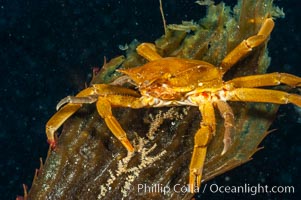
Northern kelp crab crawls amidst kelp blades and stipes, midway in the water column (below the surface, above the ocean bottom) in a giant kelp forest.
Species: Northern kelp crab, Macrocystis pyrifera, Pugettia producta
Location: San Nicholas Island, California
Image ID: 10216
Species: Northern kelp crab, Macrocystis pyrifera, Pugettia producta
Location: San Nicholas Island, California
Image ID: 10216
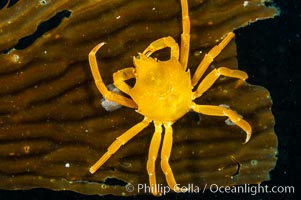
Northern kelp crab crawls amidst kelp blades and stipes, midway in the water column (below the surface, above the ocean bottom) in a giant kelp forest.
Species: Northern kelp crab, Macrocystis pyrifera, Pugettia producta
Location: San Nicholas Island, California
Image ID: 10220
Species: Northern kelp crab, Macrocystis pyrifera, Pugettia producta
Location: San Nicholas Island, California
Image ID: 10220
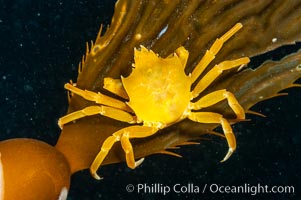
Northern kelp crab crawls amidst kelp blades and stipes, midway in the water column (below the surface, above the ocean bottom) in a giant kelp forest.
Species: Northern kelp crab, Macrocystis pyrifera, Pugettia producta
Location: San Nicholas Island, California
Image ID: 10223
Species: Northern kelp crab, Macrocystis pyrifera, Pugettia producta
Location: San Nicholas Island, California
Image ID: 10223
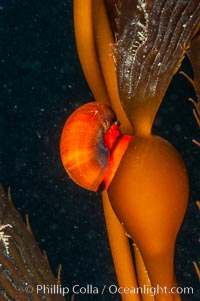
Norris topsnail (aka, kelp snail), clings to a kelp pneumatocyst (bubble) at the base of a stipe/blade, midway in the water column.
Species: Norris' top snail, Macrocystis pyrifera, Norrisia norrisi
Location: San Nicholas Island, California
Image ID: 10213
Species: Norris' top snail, Macrocystis pyrifera, Norrisia norrisi
Location: San Nicholas Island, California
Image ID: 10213
